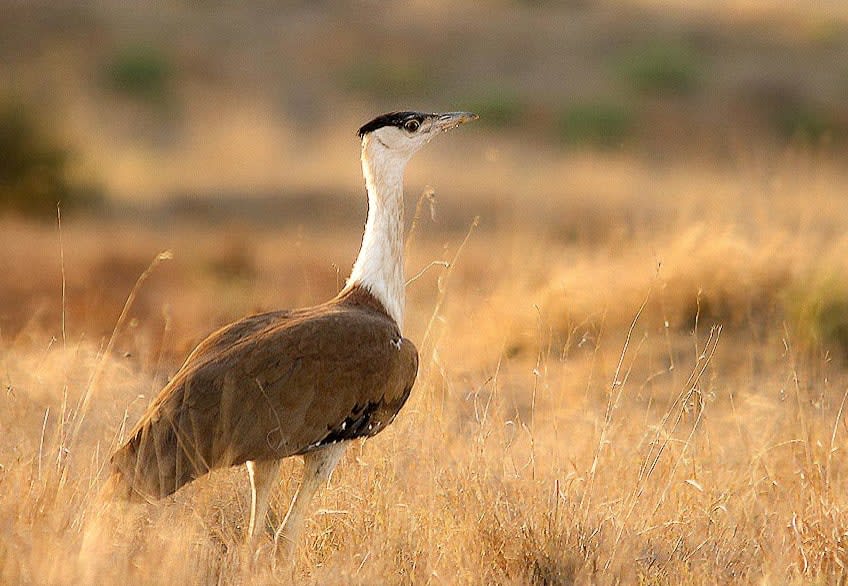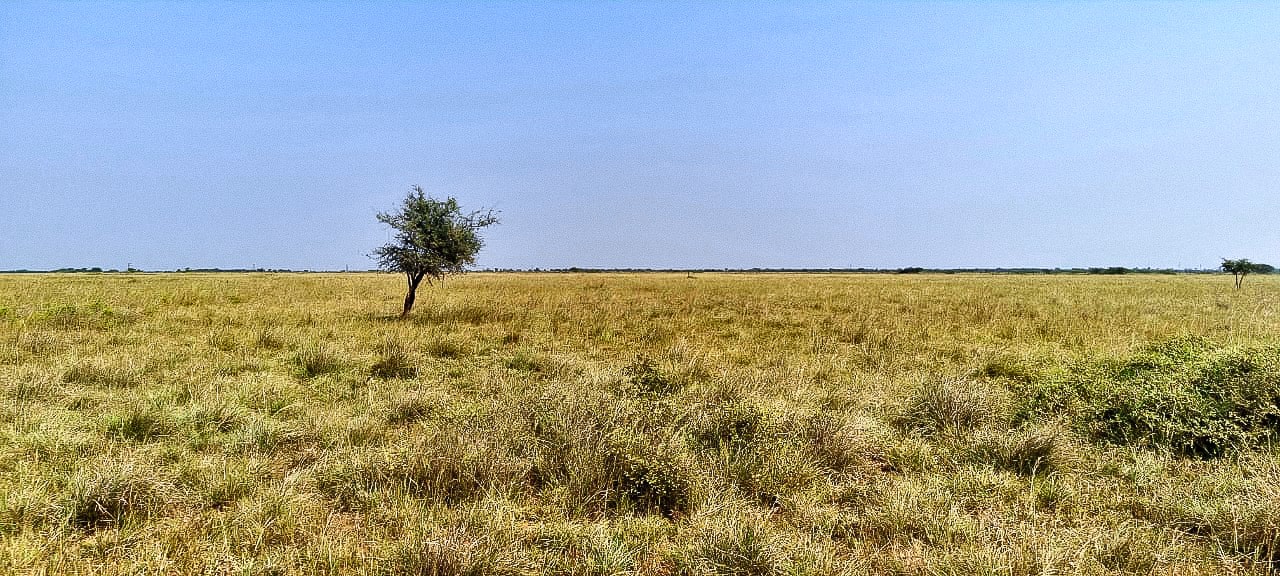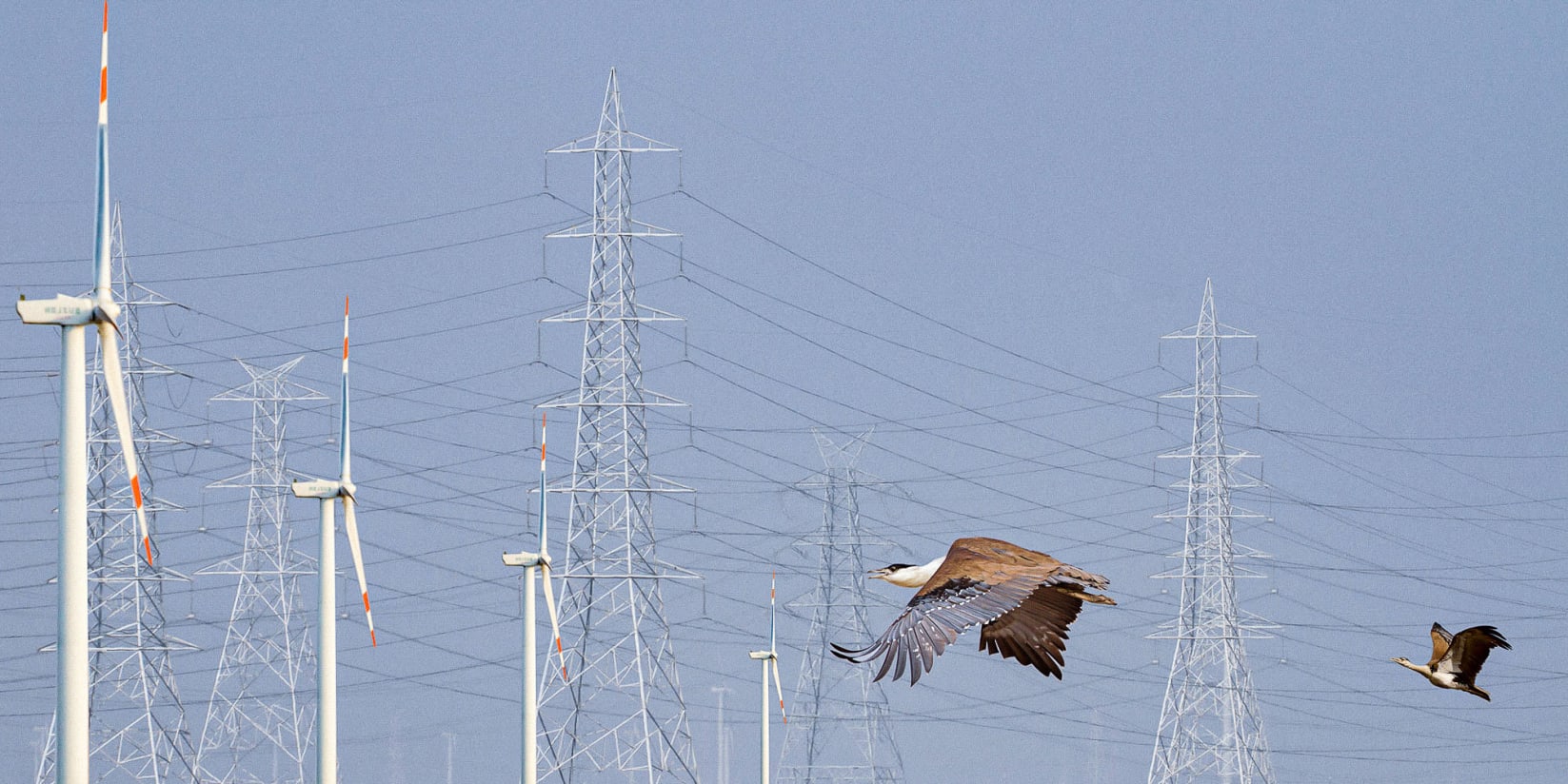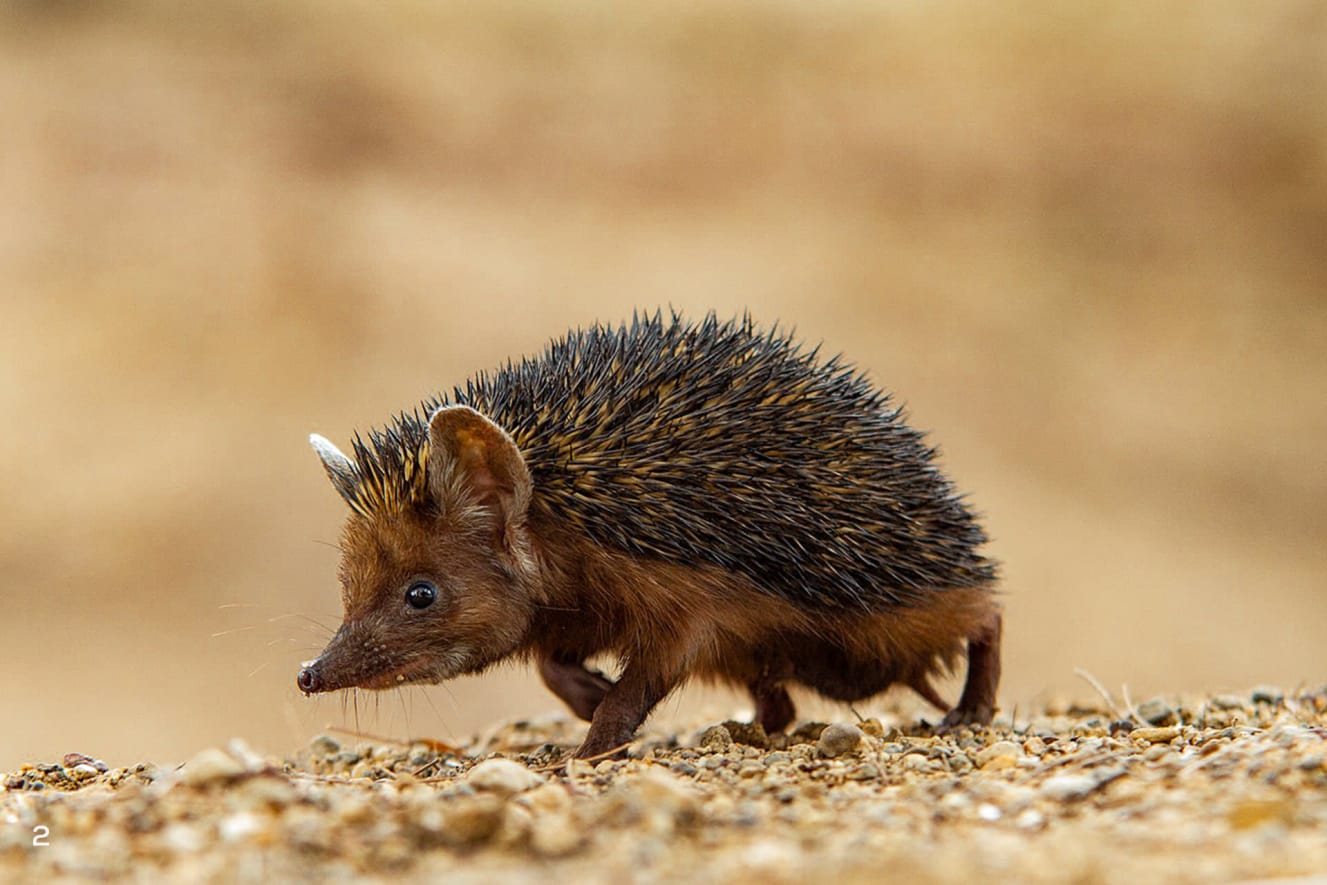 Listen to this article
•
15:34 min
Listen to this article
•
15:34 min
On a sunny morning in March 2012, I was with Dr Devesh Gadhavi, my colleague, friend, and mentor on birds of open ecosystems. We were exploring the vast semi-arid grassland habitat in Abdasa tehsil of Kutch, the last remaining home of the great Indian bustard, Ardeotis nigriceps (GIB) in Gujarat. I have never seen anybody spot birds hidden in the grasslands and shrubbery better than Devesh. Scanning and panning his binoculars, he spotted tawny, short-toed eagles sitting atop the few remaining native Acacia trees amidst the proliferation of the exotic Neltuma juliflora (previously known as Prosopis juliflora) that has practically engulfed grasslands and semi-desert areas in western India. Devesh’s eyes never miss the well-camouflaged little fellas either — prinias, coursers, larks, quails, sandgrouse. As we meandered through the grasslands, spiny-tailed lizards occasionally popped out of their burrows, as did Indian desert gerbils. It was the first place I saw short-tailed agamas in such abundance. The entire landscape was thriving with life forms, small and large, making it a complete ecosystem.

Passing a bend and a small mound in a grassland near Kunathia village, we crossed paths with one of the largest GIBs I have ever seen. It was a male, fondly named Abdul by local forest department staff and village folks, as a tribute to a tall, local forest staff member. The GIB was handsome, his white neck shining in the morning sun. His black crown feathers fluttered in the wind as he walked elegantly in front of us without showing any sign of being disturbed. We remained silent but could not help the noise our camera shutters made as we captured his every movement. He skilfully caught a large grasshopper, fed on some fallen grain, and occasionally stopped to scan his home with head held four feet high. “He will reach the famous ‘Bustard Display Arena’ of Naliya grassland soon”, Devesh said. We left him alone and moved further away to witness the beauty of this pristine agro-pastoral landscape. At Kalatalav Khirsara village, a leakage from a pipeline had created a puddle, where we were lucky to spot 200 chestnut-bellied sandgrouse.
Reaching the Naliya grassland early the next morning, we saw the GIB male was indeed near the high mound, ready for its famous courtship display. His gular pouch wobbled like a pendulum and hung close to the ground, like a naulakha haar (valuable necklace). Not wanting to play a spoilsport in this matchmaking, we backed off, wishing Abdul luck in making more bustards.
Abdasa: Land of the GIB
My first visit to the “Land of the GIB” was in July 2009 when I joined The Corbett Foundation (TCF), founded by conservationist (late) Dilip Dharamsey Khatau.
The Abdasa landscape was rustic, vast and seemingly never-ending, and dotted with windmills near the Jakhau coast. It is the only area in India where three bustard species are seen: the resident and critically endangered GIB and lesser florican, and the winter migrant, the vulnerable Asian houbara. The day when I captured three GIBs and two Asian Houbara together in one frame in Konathiya-Dhufi donn (grassland in Kutchi) was memorable.

Back then, GIBs in Kutch were a sure sight, although their numbers had dwindled from around 1,200 in the 1960s to 48 in 2008. The encroachment by a few influential locals on grasslands under the jurisdiction of the revenue department was on the rise. Unfortunately, these areas are still categorised as “revenue wastelands”, ridiculous terminology that the British coined. It shows a lack of fundamental knowledge about the nuances of natural open ecosystems, such as grasslands, which are globally acknowledged as better carbon sinks than forests.
Kutch, the last bastion
Kutch has been known as the last bastion for GIBs in Gujarat, where these birds moved over 2,000 sq km. But ironically, a grassland patch of only two square kilometres was notified as the Kutch Bustard Sanctuary in 1992. Additionally, a few fragmented grassland patches in Naliya, Parjau, Kunathia, Bhachunda, Dhufi, and nearby areas were protected by the forest department. However, these too suffered the pressures of indiscriminate livestock grazing. In 2011, based on research done by Dr Sutirtha Dutta, an exceptional scientist from the Wildlife Institute of India (WII), the IUCN declared the GIB as “Critically Endangered”. By 2011, the bird had been wiped out from 90 per cent of its former range. Many conservationists rang alarm bells about the plight of the GIB, but their pleas fell on deaf ears.
From the year 2000 onwards, the Government of India encouraged the exploitation of Abdasa for large-scale solar and wind energy projects. Voluminous Environmental Impact Reports (EIA) made only a passing mention of the GIB and overlooked its needs. Expanding infrastructure quickly transformed the landscape faster than the GIBs could adapt, threatening their survival.
These drastic changes to the Kutch landscape concerned us, as we knew that GIBs would not be able to cope. In October 2012, TCF released an SOS report identifying key habitat patches essential to the long-term survival of bustards in this landscape. Between 2012 and 2020, this report was presented to three Chief Ministers of Gujarat, Collectors, and other senior government officials, with a plea to leave aside at least a few areas for the GIBs to breed and survive. Our pleas were met with assurances and lip service to protect the ghorad (GIB), while land use changes continued. Only fragmented patches of the vast grasslands now remained, interspersed with cash crop farms. The open skies where once flocks of hundreds and thousands of cranes, flamingos, herons, harriers, larks and pipits flew now had hundreds of pylons and a dense network of power lines crisscrossing the skies, creating impediments in the flight route of not only bustards but also cranes, vultures, eagles and larks. Meanwhile, TCF continued to collaborate with the forest department to develop the “Recovery Plan for the Great Indian Bustard in Kutch, Gujarat,” which laid the blueprint for protecting the last remaining bustard habitat in Abdasa.
GIBs in the landscape attempted to adapt to these rapid changes in their homeland, with little success. Carcasses of a couple of GIB females deployed with satellite transmitters were found under the power lines. Perhaps Abdul met a similar fate, as he was untraceable after 2018. By then, we feared the loss of many more bustards to the killer power lines, as GIB sightings drastically reduced from 10-12 sightings per day to 1-2 sightings every 10-12 days. The GIB’s limited frontal vision and heavy body make manoeuvring to avoid power lines difficult. The GIB habitat in the Thar Desert of Rajasthan was undergoing the same transformation. Windmills towered over dunes, and the power lines filled the beautiful sky, without any consideration towards avoiding the GIB habitat. Saving the GIB and its habitat remained on paper. By 2018-19, the GIB population in India had presumably dwindled to less than 100.

Taking matters to court
When all efforts to convince the government failed to secure the GIB’s future, the only option and ray of hope left was the judiciary. As a last option, a Public Interest Litigation (PIL) was filed in 2019 in the Supreme Court by the renowned wildlife conservationist and architect of India’s Wild Life (Protection) Act, Dr M. K. Ranjitsinh, along with others, including TCF. The petition only prayed for immediate measures to prevent the extinction of the GIB and the lesser florican, as their numbers across India had dwindled to 600-700 in 2017-18. The petition never opposed development. Instead, it requested that power lines in the GIB priority habitat be buried underground. This request was supported by WII's research, which documented the movement of GIBs, deployed with satellite transmitters, in Kutch and the Thar Desert.
This research data was verified through critical observations on the ground and by compiling peer-reviewed research articles and evidence-based documentation on the feasibility of laying high-tension power lines underground across the world, including in India. The suggestion to install bird flight diverters (BFDs) on the most critical power lines, rather than laying them underground, was refuted with strong scientific evidence showing their low efficacy. BFDs cannot be an alternative to laying critical power lines underground, but they can be used on the power lines of potential areas . In April 2021, the Supreme Court issued a landmark order to lay underground all existing power lines in the GIB priority area. This order provided much hope that, finally, we would prevent the extinction of the GIB. However, this joy was short-lived as we soon realised that there was tremendous reluctance and apathy about the implementation of the Supreme Court’s order. Shockingly, renewable energy projects continued to expand in GIB landscapes in Gujarat and Rajasthan.
Conservation in the time of habitat loss
Now, fewer than four GIB females survive in Kutch. No male had been sighted since 2018. This was a cause for great worry as this all-female population was “ecologically dead”. Meanwhile, in 2018, the Conservation Breeding Programme of the GIB started in Rajasthan. A dedicated team of WII, led by Dr Dutta, worked tirelessly to make this project a success. From a few eggs collected from the wild and hatched artificially, the founder population in captivity was established. Eventually, they bred, and today, a decent inventory of around 70-odd GIBs survives in this facility. Their future offspring will be released in the wild. But the million-dollar question remains: Is there a safe habitat left in India where the GIBs from the Conservation Breeding Centre can be released? As of now, the answer to this question is a negative, and, therefore, the extinction of GIB from the wild may still occur. Lesser floricans, the smaller cousins of the GIB, likely face a grimmer situation than the GIB, as their numbers have drastically declined, as evident from surveys conducted by WII, TCF, and BNHS in 2025. Sadly, the conservation breeding efforts for the lesser florican have not been successful so far, with the birds raised in captivity yet to breed.

Green versus Green
Adding to these woes, the April 2019 order passed by the Supreme Court was revised in 2024. A broader order was passed, which included climate action as one of the issues to be considered and addressed while deciding the GIB’s future. Though we all welcome this addition of climate action as one of the end results, it may not necessarily help prevent the extinction of the GIB and lesser florican.
Renewable energy is often seen as a solution to mitigate the impacts of climate change, a questionable assumption in itself. Experts have raised concerns about the negative environmental impacts of renewable energy infrastructure and its substantial environmental footprint. There is no solution to address the safe and environmentally friendly disposal of waste generated, and the humongous amount of water required to maintain the efficacy of this infrastructure. The latest research also indicates that nearly 1,00,000 birds of around 50 species die annually due to collisions with power lines in 4,000 sq km of the Thar Desert.
However, there are examples in the world where technology and science have been effectively used to avert extinctions. One of the finest examples is of the great bustard, found in parts of Europe and Central Asia, which was successfully saved from extinction by ex-situ and in-situ conservation measures.
Unfortunately, the entire narrative in the public domain about this PIL was presented as Bustard vs Renewable Energy. In 2024, the Supreme Court appointed a high-level seven-member committee to prepare a comprehensive bustard conservation plan for Gujarat and Rajasthan. After much deliberation and disagreements, this committee submitted its reports in May 2025. Now, the future of the GIB depends on the final order the Supreme Court delivers and its implementation in letter and spirit by the Ministry of Environment, Forest and Climate Change, Government of India, and other stakeholders.

In search of a way forward
While arguments in court have so far rightly focused on mitigating the threats from power line collisions, other important factors imperil bustards. Predation by free-ranging dogs, excessive use of pesticides that poison their principal food (insects), permanent damage to grassland habitats due to tree planting, proliferation of invasive plant species, lack of understanding of bustard ecology, and lack of interest among policymakers to treat bustards at par with tigers are some of the lingering issues that need to be addressed with utmost priority.
Since the bustards are birds of agro-pastoral landscapes, the local community engagement remains pivotal to the long-term conservation of these birds. Promoting bustard-friendly agricultural practices through government-backed incentive schemes, restoring habitats by eradicating invasive plant species, and restoring and recreating grasslands that benefit bustards and local communities are the most promising coexistence measures we must promote across the birds’ range in India. It is important to understand the suitability of habitats in the breeding, feeding, and wintering areas of bustards when developing any conservation plans.
GIB is close to the verge of extinction in the wild, and the plight of the lesser florican is probably worse. Very little time is available to rectify our mistakes and pave the way for policy changes, such as formulating a comprehensive grassland policy for India that will provide a scientific approach to species conservation, habitat protection, and sustainable use. I remain hopeful that over the next 10 years, we will see efforts to reintroduce and rewild bustards in their former habitats in Gujarat, Rajasthan, Maharashtra, Karnataka, Andhra Pradesh, and Madhya Pradesh. But this wishful thinking would come true only if the political will is in favour of the bustards.








